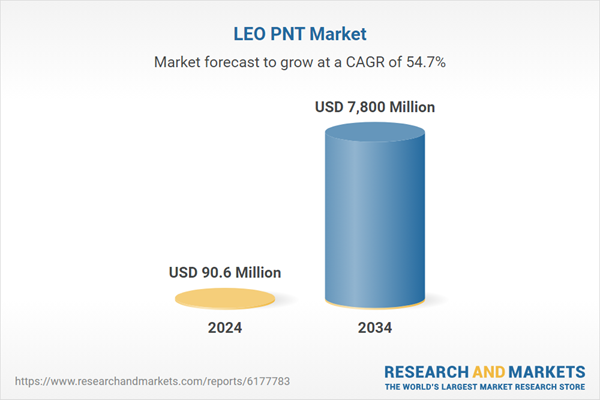The sharp expansion of this market is primarily influenced by the increasing integration of satellite-based navigation systems across commercial and defense verticals. Demand continues to grow for secure, accurate, and resilient navigation systems due to the rapid proliferation of autonomous vehicles, UAVs, IoT-enabled devices, and next-generation networks. The expanding footprint of 5G infrastructure and future advancements toward 6G also play a crucial role in accelerating LEO PNT deployments, where precise synchronization and timing are vital for uninterrupted performance. As ultra-reliable connectivity becomes a priority, LEO PNT systems are emerging as a critical component in ensuring stability under high network stress. Additionally, shifting requirements in secure positioning solutions and real-time response systems have increased the emphasis on space-based alternatives that go beyond the limitations of traditional GPS networks.
The market has been significantly transformed by the rapid deployment of satellite constellations. This trend, which began intensifying in the early 2020s, was made possible through advances in spacecraft miniaturization and declining production costs. Smaller satellite systems are now enabling greater coverage, faster response times, and enhanced reliability in navigation systems. The fusion of LEO PNT capabilities with 5G and upcoming 6G networks is shaping the next phase of the market, particularly in enabling ultra-precise location services for autonomous technologies and real-time IoT operations. By the end of the 2020s, the industry had largely matured in its ability to deploy PNT systems in harmony with 6G infrastructure, improving both reach and responsiveness across sectors.
In 2024, the hardware segment was valued at USD 40 million, backed by growing demand for compact, high-performance satellite components. Increasing investment in LEO platforms, paired with innovations in radiation shielding, energy optimization, and size reduction, is propelling this segment forward. Hardware developers are shifting toward modular, scalable systems that can be integrated into evolving satellite architectures and meet the demands of next-generation PNT systems. Solutions that balance power efficiency with durability are particularly vital as mission lifespans and performance expectations continue to grow.
The L-Band frequency spectrum held 39.2% share in 2024, driven by its long-standing reliability in satellite communication and navigation functions. Its strong resistance to interference and dependable performance under varying environmental conditions makes it a preferred band for high-stakes applications in airspace control, marine navigation, and mobile systems. As precision timing and stable connectivity become mission-critical, the L-Band remains an essential asset for LEO-based PNT deployment.
U.S. LEO PNT Market was valued at USD 36.1 million in 2024, bolstered by rising federal and commercial investments in next-generation navigation technologies. National focus on improving military navigation infrastructure, commercial LEO satellite rollouts, and the growth of widespread 5G/6G networks are central to this upward trend. To meet growing needs for accuracy and resilience in navigation, U.S.-based manufacturers are prioritizing low-latency PNT systems, increasing satellite output at scale, and strengthening public-private partnerships to accelerate adoption across defense and enterprise sectors.
Leading companies operating in the LEO PNT Market include Rakon Limited, CACI International Inc., GMV Innovating Solutions S.L, Satelles, Inc., Xona Space Systems, Inc., Thales Alenia Space, L3Harris Technologies, Inc., VIAVI Solutions Inc., Honeywell International Inc., SYNTONY, Airbus, TrustPoint, Inc., General Dynamics Corporation, Celestia Technologies, Hexagon AB, Microchip Technology Inc, OneWeb Technologies Inc., Fugro, and Safran. To solidify their positions in the competitive LEO PNT Market, companies are adopting strategies such as investing in satellite miniaturization, increasing component integration, and expanding their satellite constellations for global coverage. Firms are also aligning their offerings with next-gen network technologies such as 5G and 6G to offer synchronized, real-time services. Collaborations with telecommunications providers and defense agencies are being actively pursued to scale deployment and gain first-mover advantages.
Comprehensive Market Analysis and Forecast
- Industry trends, key growth drivers, challenges, future opportunities, and regulatory landscape
- Competitive landscape with Porter’s Five Forces and PESTEL analysis
- Market size, segmentation, and regional forecasts
- In-depth company profiles, business strategies, financial insights, and SWOT analysis
This product will be delivered within 2-4 business days.
Table of Contents
Companies Mentioned
The companies profiled in this LEO PNT market report include:- Airbus
- Honeywell International Inc.
- L3 Harris Technologies, Inc
- Thales Alenia Space
- General Dynamics Corporation
- CACI International Inc.
- Microchip Technology Inc
- OneWeb Technologies Inc.
- Satelles, Inc.
- TrustPoint, Inc.
- VIAVI Solutions Inc.
- Fugro
- GMV Innovating Solutions S.L
- Hexagon AB
- Rakon Limited
- Safran
- SYNTONY
- Xona Space Systems, Inc
- Celestia Technologies
Table Information
| Report Attribute | Details |
|---|---|
| No. of Pages | 190 |
| Published | September 2025 |
| Forecast Period | 2024 - 2034 |
| Estimated Market Value ( USD | $ 90.6 Million |
| Forecasted Market Value ( USD | $ 7800 Million |
| Compound Annual Growth Rate | 54.7% |
| Regions Covered | Global |
| No. of Companies Mentioned | 20 |









